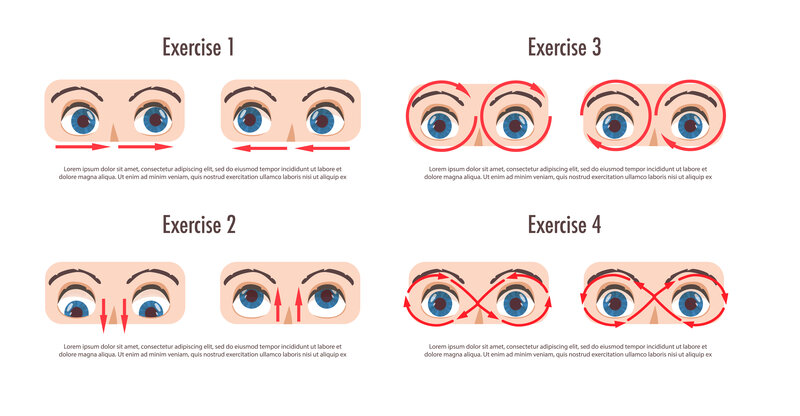Eye Exercises To Improve Vision

Are you doing your daily eye exercise? The eyes focus by activating muscle fibers that coordinate with the optic nerve. So, using eye exercises to keep eye muscles in shape can improve vision and focus.
While eye exercises are beneficial for anyone, exercising the eyes each day can improve vision for people with:
- Nystagmus (rapid eye movements)
- Lazy eye (amblyopia)
- Cross eyes
- Dyslexia
- Motion sickness
- Visual field issues
- Ocular motility defects (difficulty moving the eyes)
- Vergence/convergence problems (how your eyes coordinate motion in sync)
5 Eye Exercises To Support Eye Health & Focus
We think everyone benefits from eye exercises, but there are signs you may need them more than not. These include:
- Unintentionally skipping lines when reading
- Eyes that feel tired or sore
- Needing to blink or wink to keep things in focus
- Eyes that tear when reading or looking ahead in the distance
- Feeling tired every time you read even though you don’t need glasses or have the correct prescription
- Headaches
If you notice anyone in the family doing any of the above or tilting their head to see better, schedule an eye exam. It may be that eye coordination or movement issues are a factor. In mild cases, routine eye physical therapy can go a long way toward correcting these issues.
In addition to improving eye function, the following five exercises help prevent eye strain - something that’s all too common in our increasingly screen-directed world.
Blinking exercises
Why would you need to blink intentionally when it’s something you do naturally? Well, it turns out that we don’t blink as much as we normally do when we’re looking at a screen. So, between the combination of computer use, smartphones, tablets, and TVs, our eyes aren’t blinking as much as they should.
At least a few times per day, take some time to blink intentionally. If you’re on a screen for work or school, set a timer for every 20 minutes to do this exercise. First, blink five to 10 times in a row to bathe and lubricate the eyes. Then, blink and hold the eyes closed for at least two to three seconds. This stimulates the oil glands, refreshing eye fluids.
We commonly “prescribe” this exercise for patients with dry eye symptoms. Sometimes, daily blinking exercises and over-the-counter, preservative-free eye drops are enough to resolve the issue.
Near and far focusing
This is another exercise you can do during screen breaks, helping the eyes focus on things closer to and further from the typical computer or phone/gadget screen.
- Hold your pointer finger in front of your face, just a few inches away from your eyes.
- Focus on it.
- Then move it arm’s length away and focus on something in the distance (at least 10 feet away)
- Focus back on your finger at arm’s length.
- Move the finger back to a few inches from your nose and focus on it again.
- Then focus on the thing in the distance again.
Repeat this exercise a few times, and you’ll feel your eye muscles working, a sign they’re “working out.”
Palming
Palming comes to us by way of the yoga studio. Rather than strengthen the eye muscles, palming helps relax the muscles and tissues around the eye. First, rub your palms together to warm them up - so they become like built-in, warm compresses. Then, rest the base of your palms on the cheekbones, cupping your eyes.
Keep your eyes closed and breathe deeply for three to five minutes.
Eye movements or Figure 8s
Some people feel a bit motion sick when they do Figure 8s, so we’re offering two different eye movement exercises. If you do get dizzy or queasy from Figure 8s, keep trying each day to see if it improves. It might just be that you need the exercise more than you realized. If it continues to be uncomfortable, let it go and do the basic eye movement exercise.
Eye movement exercises
For this exercise, you close your eyes and then move your eyeballs as far as they’ll comfortably go in multiple directions:
- Up & down (repeat three times)
- Left side/right side (repeat three times)
- Around in circles clockwise and then counterclockwise (repeat each direction three times)
Figure 8 eye therapy
For this one, you’ll move your eyes in a figure 8. Focus on a spot on the floor about eight feet away from you. Then make a figure 8 with your eyes, and trace that same figure 8 shape for 10 to 30 seconds. Then switch directions and make the same figure 8 but in reverse.
Set up a Brock String eye exercise gym
This exercise was created by a Swiss optometrist, Frederick W. Brock. It’s designed to coordinate eye movement and equalize strength between both eyes. You’ll need a piece of white or light-colored yarn, string, or twine and three beads to do it. Cut the string to a 10 to 15-foot length and string the three beads onto it. Then, create a slip not at each end so you can reuse the same string repeatedly.
Loop one end of the string on a door knob and move the furthest of the three beads down at the doorknob end. You’ll stand with the string fairly taught - placing you around 10 feet or so from the door. Then move the middle bead to about two to five feet away from you. The nearest bead should be placed six inches from your nose.
Now, stand directly across from the doorknob with the loop around your index finger, and hold your finger right under your nose, as if telling someone to be quiet. Next, focus on the first bead and see if it’s single or double. If you see two beads instead of one, move the bead down a bit more until it’s single again. Over time, you’ll be able to move the bead just an inch from your eyes, proving the eye exercise works.
Click Here to read the rest of the instructions on how to do a complete Brock String exercise set.
Eye To Eye Family Vision Care: Eye Exercises For Vision Health
At Eye to Eye Family Vision Care, we see firsthand how lifestyle choices affect vision health, including physical and eye exercises that keep muscles and nerves working together. Schedule an appointment to at our clinic in Sapupla, near Tulsa, OK to learn more about how eye exercises and routine exams lead to lasting vision.

